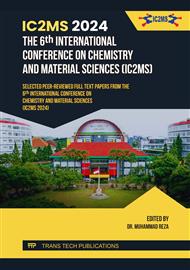[1]
S. Dhal, A. Anis, H. M. Shaikh, A. Alhamidi, and K. Pal, "Effect of Mixing Time on Properties of Whole Wheat Flour-Based Cookie Doughs and Cookies," Foods, vol. 12, no. 5, 2023.
DOI: 10.3390/foods12050941
Google Scholar
[2]
A. Nawaz et al., "Effect of Structurally Different Pectin on Dough Rheology, Structure, Pasting and Water Distribution Properties of Partially Meat-Based Sugar Snap Cookies," Foods, vol. 10, no. 11, 2021.
DOI: 10.3390/foods10112692
Google Scholar
[3]
W. El Kiyat et al., "Review: Extraction of Pectin from Kedondong Bark Waste (Spondias dulcis) and Its Utilization as an Edible Coating on Fruit," IJCA (Indonesian J. Chem. Anal., vol. 2, no. 01, 2019.
DOI: 10.20885/ijca.vol2.iss1.art1
Google Scholar
[4]
N.- Musita, "Characteristics of Pectin Extracted from Cocoa Pod Husks," Pelita Perkeb. (a Coffee Cocoa Res. Journal), vol. 37, no. 1, page 62–75, 2021.
DOI: 10.22302/iccri.jur.pelitaperkebunan.v37i1.428
Google Scholar
[5]
F. Yanto, M. Lasindrang, and S. Une, "Effect of Adding Pectin from Salak Fruit Peel Extract on the Physical Properties of Kepok Banana Peel Jam," Jambura J. Food Technol., vol. 2, no. 2, page 1–10, 2020.
Google Scholar
[6]
F. Blanco-Pérez, H. Steigerwald, S. Schülke, S. Vieths, M. Toda, and S. Scheurer, "The Dietary Fiber Pectin: Health Benefits and Potential for the Treatment of Allergies by Modulation of Gut Microbiota," 1 Oktober 2021, Springer.
DOI: 10.1007/s11882-021-01020-z
Google Scholar
[7]
Z. S. Vásquez et al., "Biotechnological Approaches for Cocoa Waste Management: A review," 2019.
DOI: 10.1016/j.wasman.2019.04.030
Google Scholar
[8]
J. Chen et al., "Extraction Temperature is a Decisive Factor for the Properties of Pectin," Food Hydrocoll., vol. 112, 2021.
DOI: 10.1016/j.foodhyd.2020.106160
Google Scholar
[9]
M. H. Tiffany, A. M. B. Samang, Indrastuti, and S. Al Islamiyah, "Scientific Review of the Potential of Pectin from Orange Peel as an Emulsifier Through Hydrophobic Modification of Pectin," J. Teknol. dan Mutu Pangan, vol. 1, no. 2, page 35–39, 2023.
DOI: 10.30812/jtmp.v1i2.2542
Google Scholar
[10]
T. R. Maulani, H. N. Lioe, I. I. Arief, and H. D. Kusumaningrum, "Extraction and Physicochemical Characterization of Pectin from Noni (Morinda citrifolia) Fruit," J. Kim. Val., vol. 10, no. 1, page 11–19, 2024.
DOI: 10.15408/jkv.v10i1.37702
Google Scholar
[11]
B. C. K. Ly, E. B. Dyer, J. L. Feig, A. L. Chien, and S. Del Bino, "Research Techniques Made Simple: Cutaneous Colorimetry: A Reliable Technique for Objective Skin Color Measurement," 2020.
DOI: 10.1016/j.jid.2019.11.003
Google Scholar
[12]
Y. X. Liu, M. J. Cao, and G. M. Liu, "Texture Analyzers for Food Quality Evaluation," in Evaluation Technologies for Food Quality, 2019.
DOI: 10.1016/B978-0-12-814217-2.00017-2
Google Scholar
[13]
AOAC International, "Official Methods of Analysis of AOAC International - 20th Edition, 2016," 20th ed. Gaithersbg. AOAC., 2016.
Google Scholar
[14]
Megazyme, "Resistant Starch (Rapid) Assay Protocol (K-RAPRS)," vol. 23, page 1–16, 2023, [Daring]. Tersedia pada: https://www.megazyme.com/documents/Assay_Protocol/K-RAPRS_DATA.pdf%0Ahttps://www.megazyme.com/resistant-starch-assay-kit-rapid?sSearch=starch
DOI: 10.1094/aaccintmethod-76-13.01
Google Scholar
[15]
Aisyah, A. Jannah, and Nurfitri, "Determination of Pectin Quality by pH Formulation of Extraction in Cocoa Shell Waste (Theobrema cacao L.)," J. Pertan. Presisi (Journal Precis. Agric., vol. 4, no. 1, 2020.
DOI: 10.35760/jpp.2020.v4i1.2863
Google Scholar
[16]
Y. V. Chekunkov et al., "New Complexes of Pectic Polysaccharides with Nonsteroidal Anti-Inflammatory Drugs," Russ. Chem. Bull., vol. 69, no. 3, 2020.
DOI: 10.1007/s11172-020-2801-z
Google Scholar
[17]
J. Lukinac, D. K. Komlenić, M. L. Čolić, G. Nakov, and M. Jukić, "Modelling the Browning of Bakery Products During Baking: a review," Ukr. Food J., vol. 11, no. 2, 2022.
DOI: 10.24263/2304-974X-2022-11-2-3
Google Scholar
[18]
B. Naseer et al., "Effect of Carboxymethyl Cellulose and Baking Conditions on In-Vitro Starch Digestibility and Physico-Textural Characteristics of Low Glycemic Index Gluten-Free Rice Cookies," LWT, vol. 141, page 110885, Apr 2021.
DOI: 10.1016/J.LWT.2021.110885
Google Scholar
[19]
Sumarni, H Ansharullah, and Nur Asyik, "Cookies Based on Yellow Sweet Potato Flour (Ipomoea batatas L.) and White Snapper Flour (Lates calcarifer Bloch)," J. Sains dan Teknol. Pangan, vol. 2, no. 2, 2017.
Google Scholar
[20]
B. Yudhistira, T. R. Sari, and D. R. Affandi, "Physical, Chemical and Organoleptic Characteristics of Green Spinach Cookies (Amaranthus tricolor) with the Addition of Tomatoes (Solanum lycopersicum) as an Effort to Fulfill Iron Deficiency in Children," War. Ind. Has. Pertan., vol. 36, no. 2, page 83, Des 2019.
DOI: 10.32765/wartaihp.v36i2.5286
Google Scholar
[21]
Badan Standarisasi Nasional, "Biskuit SNI 2973: 2011," Jakarta BSN, page 1–46, 2011.
Google Scholar
[22]
U. Yasinta, "Effect of Substitution of Wheat Flour with Banana Flour on the Physicochemical and Organoleptic Properties of Cookies," J. Apl. Teknol. Pangan, vol. 6, no. 3, page 119–123, 2017.
DOI: 10.17728/jatp.200
Google Scholar
[23]
V. Chandel, D. Biswas, S. Roy, D. Vaidya, A. Verma, and A. Gupta, "Current Advancements in Pectin: Extraction, Properties and Multifunctional Applications," 2022.
DOI: 10.3390/foods11172683
Google Scholar
[24]
T. Sasaki, I. Sotome, and H. Okadome, "In Vitro Starch Digestibility and In Vivo Glucose Response of Gelatinized Potato Starch in the Presence of Non-Starch Polysaccharides," Starch/Staerke, vol. 67, no. 5–6, 2015.
DOI: 10.1002/star.201400214
Google Scholar
[25]
Y. Bai, P. Wu, K. Wang, C. Li, E. Li, and R. G. Gilbert, "Effects of Pectin on Molecular Structural Changes in Starch During Digestion," Food Hydrocoll., vol. 69, 2017.
DOI: 10.1016/j.foodhyd.2017.01.021
Google Scholar
[26]
W. Jin et al., "Effect of Pulsed Electric Field on Assembly Structure of a-Amylase and Pectin Electrostatic Complexes," Food Hydrocoll., 2020.
DOI: 10.1016/j.foodhyd.2019.105547
Google Scholar
[27]
D. Lin, Y. Ma, W. Qin, D. A. Loy, H. Chen, and Q. Zhang, "The Structure, Properties and Potential Probiotic Properties of Starch-Pectin Blend: A review," Food Hydrocoll., vol. 129, page 107644, Agu 2022.
DOI: 10.1016/J.FOODHYD.2022.107644
Google Scholar


